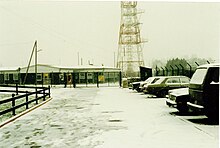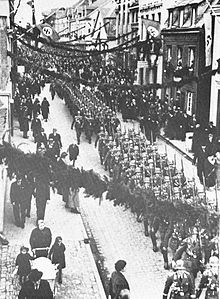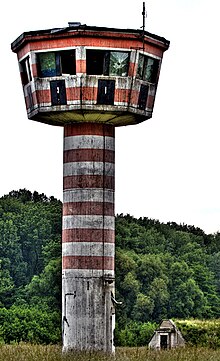Werl Air Base

The airbase Werl was a military airfield , in 1936 by the Air Force of the Armed Forces was inaugurated. The airfield to the north of Werl next to the correctional facility was used by NATO forces after the end of the Second World War and was finally abandoned in 1994. After the facilities were demolished, the KonWerl 2010 industrial park is now on the site .
planning
The first explorations of the topographical conditions took place in 1934. The construction project was announced to the public in the middle of the year. On the one hand, because of the expected economic upturn, there was approval among the population, and on the other hand, there was rejection from the farmers concerned, who should give up their land on Melsterberg. They should be redeemed by compensation or land swap. Radio Luxemburg reported that the National Socialists want to build an air base in both Werl and Dortmund. This message was initially denied by Berlin. In November 1934, a first office for the master builder Espenschied and his deputy Hörmann was set up in the Villa Wulf under the innocuous name Deutsche Verkehrsfliegerschule Werl . The construction management was housed in a newly built barrack near Scheidinger Strasse. The construction management consisted of the specialist areas of civil engineering, electrics and technical areas.
construction
Construction began in January 1935. Building construction and civil engineering were carried out by Berger and Hitzbeck; Siemens supplied the technical equipment for the airfield. Every day, the Rosenkranz bus company drove 1,000 workers from Herne and the surrounding area to the construction site. In Werl, too, there were hardly any more unemployed. Everyone suitable found a job here. Work was carried out in shifts day and night, regardless of the weather conditions. The workers were able to get supplies for little money from a canteen set up by the Wellhausen company from Wuppertal.
After leveling the terrain, it was found that in this former meadow area with clay - and clayey rainwater collected underground and not seeped. In this condition, the area could not be used as an airfield. It was decided to remove the entire already leveled area by approx. 65 cm. During this work, the remains of a Roman settlement were found and coins from this period were found. Furthermore, shards from the time of the ribbon ceramics were recovered.
On March 1, 1935, the establishment of the Luftwaffe was officially announced and on April 1, 1935 the German Aviation School Werl was renamed to Werl Airfield Site Management . Around 1,500 people were now employed here. Aircraft hangars, a shipyard, barracks with troop accommodation, a parade ground and sports facilities, the armory as well as a casino and several ancillary buildings were built around the extensive area of the airfield . These buildings were heated by a central thermal power station. Finally, concrete runways were laid. It was planned and built according to the latest technology at the time. The circular runway was surrounded by a concrete taxiway with seven hangars and a rifle range for zeroing in on-board weapons. The two conical landing and take-off runways were laid out in an east-west orientation for strategic reasons. Four tank farms were hidden under the grassy areas of the runway. The total construction costs were around four million Reichsmarks .
inauguration
The air base was inaugurated on April 7, 1936, with great sympathy from the population. Thus Werl was a garrison town . The blue-gray uniforms of the young air force soldiers shaped the cityscape for several years. With a large parade, the Werl Fliegergruppe of Jagdgeschwader 134 " Horst Wessel " marched into the city, which was lavishly decorated with flowers and fir greenery. The soldiers were greeted by BDM girls at the entrance to the city and decorated with flowers. The first airfield commander was Major Theo Osterkamp , a highly decorated Air Force officer. At around 5:00 p.m., the aviator general Hans Halm arrived and walked down the front of the formations to the sounds of the presentation march . Mayor Richard Klewer gave a speech with the usual slogans of the time. The air base was inaugurated.


Operation
Four weeks before the airport officially opened, the planes had to carry out their first assignment. The mission led to the Eifel, to protect invading landing troops from enemy attacks. At the beginning the Horst Wessel squadron was equipped with machines of the Arado Ar 65 and Ar 68 types . The aircraft of a squadron were numbered from one to twelve, the traditional color of the squadron was brown. The single-seat Arado aircraft were each armed with two synchronized MG 17 machine guns .
A shooting range was built on Neheimer Strasse about four kilometers away for shooting training. Here people shot at figures or targets with pistols, carbines and machine guns.
In the later years of the war, more and more machines from units not stationed here were repaired in the aircraft yard, and the on-board weapons were shot in at the shooting range. Quite a few night fighters in Werl were equipped with the "Lichtenstein" radar device.
A band with around 25 musicians was subordinate to the air base command. This played at military and party events. Many entertainment concerts for the population were also given.
The air base had the field post number 02446. It had the code name "Wagenrad".
Bogus airport and bogus industrial plant
The soldiers of the Werl Air Base erected wooden dummy aircraft between Eincke and Klotingen to fool enemy bomber groups into an airfield. Six soldiers were required to operate this system, who could protect themselves in a specially built bunker in the event of air raids.
Ten wooden halls measuring 10 mx 20 m were set up at Haarhöhe , west of Ruhne . In the event of an air raid, welding work and a blast furnace tapping were simulated here in order to deceive attacking associations. A similar mock system stood in front of Schlückingen, west of the Werler Forsthaus.
Stationed units
The following associations were stationed on the field:
| Association | Beginning | The End | comment |
|---|---|---|---|
| II./JG 134 | 1.04.1936 | 11/1/1938 | with Arado Ar 65 and Arado Ar 68 |
| I./JG 142 | 11/1/1938 | 01/01/1939 | with Messerschmitt Bf 109 |
| II./ZG 142 | 01/01/1939 | May 1, 1939 | with Messerschmitt Bf 109 |
| II./ZG 26 | May 1, 1939 | October 1, 1939 | with Messerschmitt Bf 109 |
| III./JG 26 | 09/23/1939 | 11/1/1939 | with Messerschmitt Bf 109 |
| II./JG 26 | 11/1/1939 | 01/27/1940 | with Messerschmitt Bf 109 |
| I./KG 77 | 10.1939 | 6.1940 | with Dornier Thursday 17 |
| I./KG 54 | May 18, 1940 | 05/30/1940 | with Heinkel He 111 |
| I./KG 54 | 05/30/1940 | 06/10/1940 | with Junkers Ju 88 |
| Rod / SKG 210 | 5.1941 | 6.1941 | with Messerschmitt Bf 110 |
| II./SKG 210 | 5.1941 | 6.1941 | with Messerschmitt Bf 110 |
| Staff / SG 1 | 01/13/1942 | 2.05.1942 | with Messerschmitt Bf 109E |
| I./SG 1 | 03/15/1942 | May 1, 1942 | with Messerschmitt Bf 109 |
| II./KG 2 | September 7, 1944 | 09/14/1944 | with Dornier Do 217E and Dornier Do 217K |
For the Blindflugschule I, the airfield was one of the external landing fields until 1945.
Airport area command
The Werl Airport Area Command was set up on July 1, 1939 in Werl and renamed to Airport Area Command 2 / VI on March 30, 1941. It was subordinate to the Luftgau Command VI, from 1943 to the Feld-Luftgau Command XXVIII Treviso. It led the following units:
- Detmold Air Base Command
- Dortmund Air Base Command
- Gütersloh Air Base Command
- Lippstadt Air Base Command
- Paderborn Air Base Command
- Fliegerhorst-Kommandantur Störmede
- Werl Air Base Command
Major flight days
Major flight days were held regularly at the air base, which served to advertise the air force among the population.
Trivia
Andreas Wessel, one of the pilots of the Werler Air Base, flew through a beer bet with his Arado 62 in an inclined position between the two towers of the pilgrimage basilica. At that moment the visitors to the high mass left the church. They threw themselves on the ground, believing this was an air raid, screaming. Wessel was punished with a temporary flight ban and three weeks' arrest. He also had the habit of throwing his dirty laundry over his mother's house in Vosswinkel . A daring flight maneuver has also been handed down, during which he flew under the Ruhr Bridge in Wickede .

Task of the air base
In mid-April 1945 the airfield was abandoned and abandoned by the German Air Force; the last commander was Major Bode. Shortly after this became known to the population, the residents streamed there in droves with horse-drawn carts, carts and handcarts and looted the complex. The camps were partly full of blankets, pots, china and parachute silk. All kinds of food were stored in the storage cellars, and everything was stolen in a short time.
Occupation time

After the end of World War II, the Belgian and American armies took over the area from Airfield B.157 , the allied code name for the airfield. The Belgians stationed the 18th logistics battalion (Batailjon Logistiek) and the 4th maintenance company (Compagnie Materieel). The Fatima Chapel was built on the site as an emergency church .
The Americans with the 4th US Army Field Artillery Detachment (USAFAD) used a barracks building and set up a nuclear weapons storage facility, a missile station and a transmission tower on the site.
On June 19, 1956, the 17th (BE) Escadrille Licht Vliegwezen was stationed on Werl as part of the 1st BE Infantry Division. Captain Buory was the first in command of this new unit. The squadron flew in helicopters from Werl airfield, which was located in the northwest part of the former air base area. The course had the ICAO code EDCW and in the 1980s had a 544 m long grass runway with the orientation 04/22.
Partial demolition and new use
The site was abandoned by the Americans and Belgians in 1994. Today the KonWerl 2010 industrial park and competence center is located there .
literature
- Helmuth Euler (ed.): Werl under the swastika. Brown everyday life in pictures, texts, documents. 2nd edition, photo study Euler, Werl 1984, p. 208.
- Amalie Rohrer , Hans Jürgen Zacher (Ed.): Werl. History of a Westphalian city. Volume 1, Bonifatius Druck Buch Verlag, Paderborn 1994, ISBN 3-87088-844-X .
Web links
Individual evidence
- ^ Karl Ries: Air bases and ports of operations of the Air Force. Plan sketches 33-45. Stuttgart 1993.
- ↑ http://www.geschichtsspuren.de/forum/viewtopic.php?t=4300&sid=3607e86d203c39cf4cbfcb7e06e58c9c
- ↑ 700 years of the city of Werl. Becoming, growing and fate of a Westphalian city on Hellweg. City of Werl, Werl 1972, p. 34.
- ↑ Creation of the new Light Aviation Escadrille 17 with location Werl. Retrieved December 18, 2019 (Dutch).
- ↑ Werl Airfield. Retrieved July 22, 2020 .
Coordinates: 51 ° 34 ′ 7.2 " N , 7 ° 54 ′ 58.1" E




